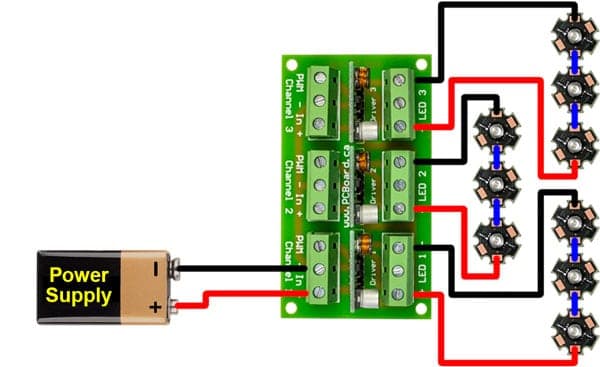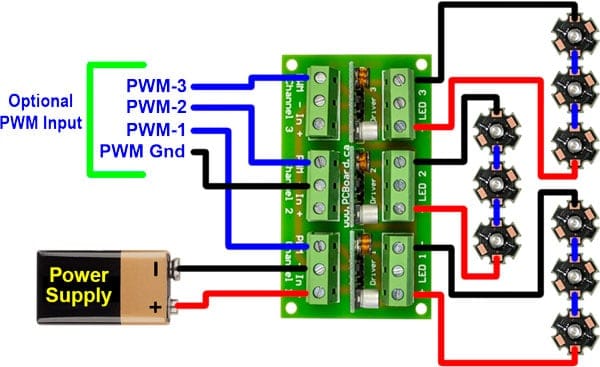High Power PWM LED Driver Board
Driver for 1 watt or 3 watt High Power LEDs
LED drivers can be a confusing part of LED technology. There are many diverse types and variations that can seem overwhelming. Their usage is imperative to the safe and successful design of a LED lighting solution.
Need full technical information on a High Power LED or LED Bead? See our LED Specifications page for full information on a wide assortment of LEDs.
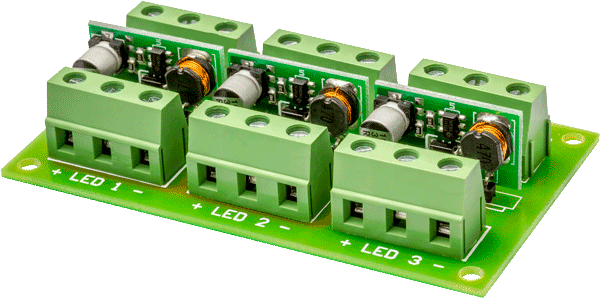
What Is A PWM LED Driver?
A LED driver is an electrical device that regulates power to an LED or a string of LEDs. Using one is very important in preventing damage to your LEDs. The forward voltage (Vf) of a high-power LED changes with temperature. Forward Voltage is the voltage the LED requires to light up. As the temperature increases, the forward voltage of the LED decreases. This causes the LED to draw more current. The LED will continue to get hotter and draw more current until the LED burns itself out. This is also known as Thermal Runaway.
A LED driver acts as a power controller with outputs matched to the electrical characteristics of the LED(s). This helps avoid thermal runaway. The LED driver compensates for changes in forward voltage while delivering a constant current to the LED.
High Power LED Lighting
LED lighting solutions are available for home and automotive needs. Some special needs solutions include IR Illumination along with LED Grow Lights. For applications like these, high power LEDs are the product of choice. High power LEDs appear in an ever-widening range of applications and appliances. This is due to their advantages over regular lighting sources. Among their advantages are higher efficiency, longer lifetime, and improved reliability. LEDs are constant-current devices and need an active driver for optimal performance.
High Power LED Driver
Our exclusive High Power LED Driver Board can hold three LED Drivers and deliver power to up to 12 high power LEDs (four per channel). The drivers used on the board are our High Power PWM Driver modules available in either 1 watt or 3 watt models.
Driver Board Design
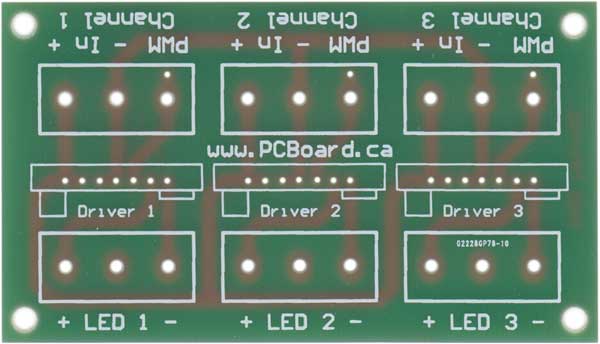
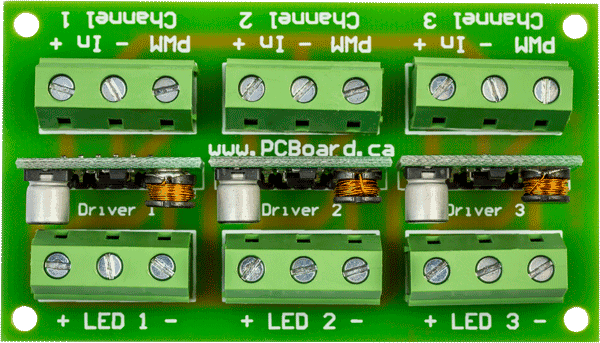
We have designed a high power LED driver solution. The design utilizes three independent driver modules. Each model can drive up to four high power LEDs for a total of 12 LEDs.
The board has provisions to install up to three drivers (located at Driver 1, Driver 2, and Driver 3). The board also has six terminal blocks to provide power and connection to the outputs.
The driver board measures only 3.5″ x 2″ (89mm x 51mm) yet provides space for all components.
The Most Common PWM LED Driver Connection
Connection to the driver board for the basic and most common operation is simple. Only a single power input and up to three outputs from the drivers. The rising clamp terminal blocks provide easy access for connections.
The terminals labeled In indicates where the power connects to the board. Each channel (labeled Channel 1, Channel 2, and Channel 3) have power input points. The power connections are common between each channel. For this reason, only one set of power connections will be required to power the board. Do not reverse the polarity of the power input or damage to the components will occur.
Power input should be DC voltages between 12v to 20v. Current requirements for running the LEDs are based on the LEDs in use.
Output from the drivers is to the three-terminal blocks. Channels 1 to 3 labels identify each output along with positive and negative connections.
With input and output connections to the board complete, apply power. The LEDs will illuminate to full intensity. Power to the strings is either 350mA for 1 watt LEDs or 700ma for 3 watt LED models.
The control board accommodates up to three current limiting modules. These can be of either the 1 watt or 3 watt drivers. Drivers can also be mixed on the board to supply power to a mixture of 1 and 3 watt LED modules.
Advanced PWM LED Driver Connection
The High Power PWM LED Driver Board is also microcontroller friendly. Each input supports PWM dimming of the connected LEDs.
On the Input terminal blocks, there is a separate PWM signal connection. This is where a 0-5v DC signal from a microcontroller can is applied to the circuit. In addition to the microcontroller signal, one common ground connection is needed between the microcontroller and the driver board.
The PWM capabilities are compatible with Arduino products like the Nano, ATTiny85, PIC microcontroller, and more.

